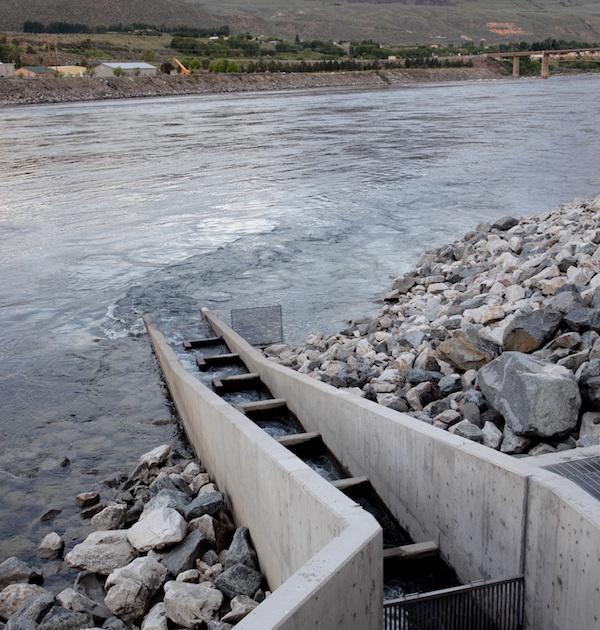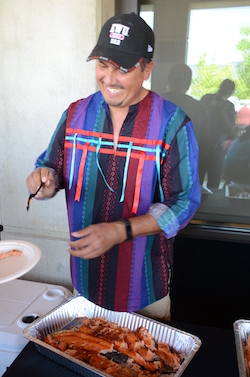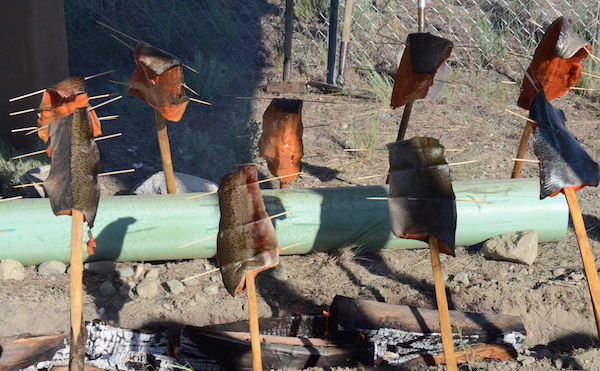Salmon Ceremony: First Chinook Return to Chief Joseph Hatchery

It was truly a “First Salmon” ceremony, not only celebrating the annual return of salmon to the river but also, in this case, the first salmon to return to the Chief Joseph Hatchery, a glorious event. The ceremony took place on May 13. The day was beautiful, salmon were in the fish ladder, and a sizable crowd was on hand, from both sides of the 49th Parallel.
“It’s central to the Syilx People’s creation stories and passed down through generations,” said Pauline Terbasket, executive director for the Okanagan (Syilx) Nation Alliance, who came down from British Columbia to attend. She spoke of the cultural importance of Ntyitix (salmon).

“The Salmon Ceremony is a beautiful experience for Indigenous Peoples who have been historically alienated from these lands, waters and foods since contact and the severity of colonial impacts upon our tribes,” Terbasket said. “We are the northern members, above the 49th, of the same cultural, geographic and linguistic group as the Colville’s.”
The Colville Confederated Tribes began work on a fish hatchery adjacent to Chief Joseph Dam in 2010 and completed it in February 2013. Salmon were introduced to the hatchery the following summer. This year marks the first return of jacks, young salmon just three years old. The first truly adult salmon will return from the ocean to spawn in 2017.
RELATED: New Chief Joseph Salmon Hatchery: Restoring the Runs, Restoring the Culture
Fishing For Compliments: Chief Joseph Hatchery Opens 70 Years Late
People began gathering at 5:30 a.m. to watch as the first fish was netted in the fish ladder. A prayer was given by Wenatchi Salmon Chief Leroy “Chas” Williams, and then he was joined by others in a song for the salmon. They were continuing a centuries-old tradition, a ceremony held throughout the salmon country of the Northwest at which the salmon chief gives thanks for their return and then allows tribal members to fish.

Colville Tribes Fish and Wildlife Director Randy Friedlander filleted the fish and returned the remainder of it to the river, in an observance of thanks, another practice conducted over many centuries. He also served as master of ceremonies prior to breakfast, which was hosted by the Colville Tribes.
The proceedings held an extra layer of meaning and attachment for Williams. As a member of the Chief Joseph Band on his father’s side, he has a direct ancestral link to the hatchery. The Chief Joseph Band is one of 12 bands and tribes within the Colville Confederated Tribes.
Williams suspects the loss of salmon for so many years, along with the loss of other native foods, is behind increases in various diseases, including diabetes, that have struck so many tribal members, including Williams himself.
“We had lots of protein, a lot of salmon,” Williams said. “It wasn’t just salmon but also elk and deer, roots and berries. My duty is to work with the hatcheries and our fish and wildlife programs so our tribal members have access to salmon.”
The hatchery produced 1.8 million Chinook smolts in 1013, and by next year it should be in full production at 2.9 million smolts annually. Only one percent of those will return four years later as adults due to loss of young fish as they move through dams downstream to the ocean, then loss in the ocean and to fishermen as the adult salmon head back up the Columbia River. Even with those losses the returning adults should number close to 30,000, enough to supply hatchery needs and greatly help in restoring this native food.
Over the course of the day, the hatchery staff discussed several projects and issues associated with salmon, including lead contamination in both fish and wildlife, and a new salmon-canning project. John Sirois, now the United Columbia Upriver Tribes Committee Coordinator discussed ongoing work to restore salmon runs upstream from the Chief Joseph and Grand Coulee dams.
Technology designed to rapidly move fish over dams by using a vacuum tube method which is showing outstanding success and minimal injury to fish at a modest price compared to modifying dams was also part of the discussion. That was followed up with a demonstration of this “whoosh” system, which attracted a lot of attention and positive comments. And salmon, of course is what was for lunch, having been skewered and cooked over an open fire during the meeting.

RELATED: First Nations Save First Foods: Northwest Tribes Seek to Restore Historic Fish Runs
The hatchery’s benefits extend way behind the Colville Confederated Tribes. It will help reestablish spring Chinook in the Okanogan River basin that reaches southward from British Columbia—another reason that Terbasket attended.
“The salmon remind me every day of hope, resilience, perseverance and courage by their instinctual and natural cycle returning to their homelands to spawn,” Terbasket said. “These ceremonies with our language, songs and prayers are an integral part of the work we undertake to ensure our sacred responsibilities. For thousands of years these ceremonies and customs have been brought forward for our children and future generations. Our peoples prayed for us and acted so we could still feast on salmon to nourish our lands and our bodies and our connection to each other. This is in part what a joining in the celebration at Chief Joseph Hatchery means to me.”
Read more at http://indiancountrytodaymedianetwork.com/2016/05/31/salmon-ceremony-first-chinook-return-chief-joseph-hatchery-164614